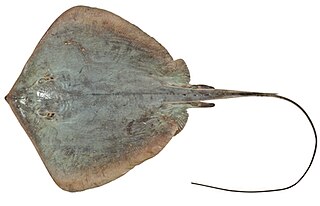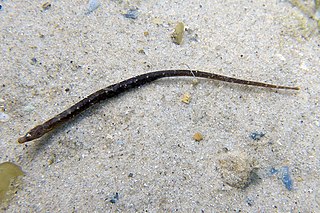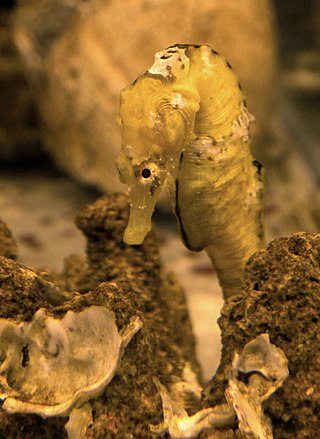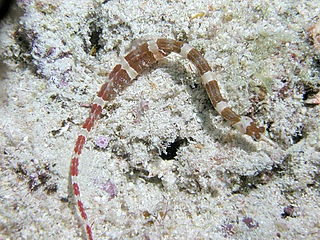
The estuary stingray, also called the estuary stingaree or brown stingray, is a species of stingray in the family Dasyatidae. Endemic to eastern Australia, it typically inhabits shallow, mangrove-lined tidal rivers, estuaries, and bays in southern Queensland and New South Wales. This yellow-brown to olive ray grows to at least 93 cm (37 in) across. It has a diamond-shaped pectoral fin disc and a mostly smooth, whip-like tail bearing both dorsal and ventral fin folds. It can additionally be identified by its long, narrow nostrils and the row of thorns along the midline of its back.

Hippocampus coronatus, commonly known as the high-crowned seahorse or crowned seahorse, is a species of fish of the family Syngnathidae. It is endemic to the Pacific coastal waters of Japan, where it lives among Zostera seagrasses. It can grow to lengths of 10.8 centimetres (4.3 in), but is more commonly 6 centimetres (2.4 in). Individuals feed mainly on small crustaceans such as gammarid amphipods and copepods, although this can vary by size, with smaller individuals consuming copepods while larger individuals feed on amphipods and mysids. This species is ovoviviparous, with males brooding eggs in a brood pouch before giving birth to live young. Breeding season occurs from June to November, with females and males reaching sexual maturity at 6.9 centimetres (2.7 in) and 7.3 centimetres (2.9 in) respectively. Male brood size ranges from 12–46. The International trade in this species has been monitored through Appendix II of the CITES licensing system since 2004 and a minimum size of 10 centimetres (3.9 in) applies to traded specimens.

The alligator pipefish or double-ended pipefish is a species of fish in the family Syngnathidae and is the only species in the monotypic genus Syngnathoides. It is found in shallow water in the tropical and subtropical Indo-Pacific, its range extending from East Africa to northern Australia. This fish lives in habitats of seagrass and seaweed, and hides by positioning itself vertically with its head down amidst the similar-coloured fronds of vegetation. The elongated, well-camouflaged body can reach 29 cm (11 in) in length. It feeds by sucking up its prey.

Campichthys is a genus of pipefishes native to the Indian and Pacific Oceans.
The upside-down pipefish is a species of pipefish endemic to the coasts of southern Australia, from New South Wales to Geographe Bay in Western Australia, where it is found in rocky reefs at depths of from 2 to 15 metres. It grows to a length of 9.2 centimetres (3.6 in) SL. This species is the only known member of its genus. Like other pipefish it is ovoviviparous but it may breed seasonally, as gravid males have been collected between September and November.

The Patagonian seahorse is a species of marine fish of the family Syngnathidae. It inhabits coastal waters from northeastern Brazil to Chubut, Argentina. It generally is found at shallow depths attached to natural or artificial substrates. This species is ovoviviparous, with males brooding eggs in a brood pouch before giving birth to live young.

Corythoichthys amplexus, known commonly as the brown-banded pipefish, is a species of marine fish in the family Syngnathidae.
Bhanotia pauciradiata is a little known marine fish of the family Syngnathidae. This species is only known from a single specimen, which was found on a reef slope near Indonesia, at a depth of around 10–12 m (33–39 ft). The specimen was 3.2 centimetres (1.3 in) long. This species is ovoviviparous, with the male carrying eggs in its brood pouch until giving birth to live young.
Campichthys galei is a species of marine fish of the family Syngnathidae. It is endemic to Australia, found from Shark Bay to the Spencer Gulf on the rubble bottom of inshore waters to depths of 18m. It can grow to lengths of 6 centimetres (2.4 in). This species is ovoviviparous, with the males carrying eggs in a brood pouch until they are ready to hatch.
Campichthys tricarinatus is a species of marine fish of the family Syngnathidae. It is found in the western central Pacific Ocean, from Montebello Island to Cape York (Queensland), and specimens have been recorded around the Northern Mariana and Marshall Islands. It is found at depths of 3–11 metres (9.8–36.1 ft), and can grow to lengths of 4.4 centimetres (1.7 in). This species is ovoviviparous, with males carrying eggs in a brood pouch until giving birth to live young.

Choeroichthys brachysoma is a species of marine fish of the family Syngnathidae.
Choeroichthys sculptus, the sculptured pipefish, is a species of marine fish of the family Syngnathidae.
Choeroichthys suillus is a species of marine fish of the family Syngnathidae. It is endemic to Australia, occurring from Perth, along northern Australia, to southern Queensland. It lives in coral reefs to a depth of 14 metres (46 ft), where it can grow to lengths of 6 centimetres (2.4 in). This species is ovoviviparous, with males carrying eggs and giving birth to live young. Within the reef it is found among coral rubble.

Doryrhamphus negrosensis, commonly known as Negros pipefish, flagtail pipefish, Masthead Island pipefish or Queensland flagtail pipefish, is a species of marine fish of the family Syngnathidae. It is found in the Western Pacific Ocean, from Borneo to Vanuatu and the Yaeyama Islands to the Rowley Shoals and the Great Barrier Reef. It lives in mud flats and reefs, both coral and rocky, where it is often associated with sea urchins. It is a rather solitary species which may be found in pairs or small groups. It inhabits depths to 9 metres (30 ft), and can grow to lengths of 6.2 centimetres (2.4 in). Although little is known of its feeding habits, it is expected to feed on harpacticoid copepods, gammarid shrimps, and mysids, similar to other pipefish, it may also act as a cleaner fish like other species in the genus Doryrhamphus. This species is ovoviviparous, with males carrying eggs before giving birth to live young. Males may brood at 4.3 cm. It is a small bluish to bluish-grey pipefish which has a pale stripe along the dorsal side of the head and snout, and a dark fan-like caudal fin which has white margins and an orange base.
Festucalex cinctus is a species of marine fish of the pipefish family Syngnathidae which is endemic to the waters off eastern Australia.
Gibbs’ pipefish is a species of marine fish of the family Syngnathidae. It is found in the Western Pacific, from the Great Barrier Reef to Palau, the Chesterfield Islands and New Caledonia. Unconfirmed specimens have been reported off of the Seychelles in the Indian Ocean. It lives in coastal sandy or rubble habitats, as well as areas with sponges and coralline algae, where it can grow to lengths of 8 centimetres (3.1 in). It is expected to feed on small crustaceans, similar to other pipefish. This species is ovoviviparous, with males brooding eggs and giving birth to live young. Males may brood at lengths of around 5 centimetres (2.0 in). The specific name honours P. E. Gibbs, who collected the type material.
Edmondson's pipefish is a species of marine fish of the family Syngnathidae. It is endemic to coastal waters of the Hawaiian Islands, from Oahu to Maui, where it inhabits shallow reefs, beaches and tidepools to depths of 33 metres (108 ft). Although this species' feeding habits are unknown, it is expected to feed on small crustaceans similar to other pipefishes. This species is ovoviviparous, with males carrying eggs in a brood pouch before giving birth to live young. Males may brood at 9.4 centimetres (3.7 in).

The Samoan pipefish, or brown pipefish, is a species of marine fish of the family Syngnathidae. It is found in the Indo-Pacific, from the Red Sea, to Sodwana Bay, to Taiwan, the Marshall Islands, and Samoa, where it inhabits tidepools and coral and rocky reefs to depths of 15 metres (49 ft). It is a solitary species with cryptic habits and is rarely observed. It is likely to feed on small crustaceans, and can grow to lengths of 14 centimetres (5.5 in). This species is ovoviviparous, with males carrying the fertilised eggs in a brood pouch, the folds of which fall well short of the centre of the egg-filled pouch, eventually giving birth to live young.

The beady pipefish is a species of pipefish of the family Syngnathidae. It is found in the Indo-West Pacific, from the western Persian Gulf, to the north central Indian Ocean, to Japan and Australia. It lives in the lower parts of streams and rivers, estuarine habitats such as seagrass beds and mangroves, and shallow inshore habitats, where it can grow to lengths of 16–18 centimetres (6.3–7.1 in). It is expected to feed on small crustaceans, similar to other pipefish. This species is ovoviviparous, with males carrying eggs in a brood pouch before giving birth to live young. Average brood size is 177.
Hippichthys spicifer, commonly known as bellybarred pipefish, banded freshwater pipefish, or blue spotted pipefish, is a species of pipefish of the family Syngnathidae. It is found in the Indo-Pacific, from the Red Sea and East Africa to Sri Lanka and Samoa. It lives in shallow coastal and estuarine habitats such as mangroves, tidal creeks, and the lower reaches of rivers, where it can grow to lengths of 18 centimetres (7.1 in). It is expected to feed on small crustaceans and mosquito larvae. This species is ovoviviparous, with males brooding eggs in a brood pouch before giving birth to live young. It is reproductively active all year, with males and females reaching sexual maturity at 10.8 and 10 centimetres respectively. Brood size can vary significantly, from 114 to 1764, with an average of 604.4 plus or minus 322.8.











